Onion Pests and Diseases
Find out here how to deal with onion pests and diseases. You wonder why something would attack an onion when there are sweeter plants nearby... but it happens.
Don't forget to practice something that never goes out of fashion — crop rotation. That's right, be up with the best, rotate your onions with other vegetable crops to prevent a buildup of disease and insect pests.
A good suggestion is onions, then carrots the next season, then potatoes, then onions again. These vegetables all have totally different pests and diseases so can't cross infect each other.
Onion pests
These are few and far between... but there's a couple of these nasty little blighters, or often a busload of these freeloaders you need to watch out for...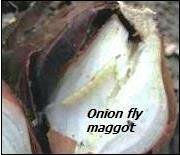
Onion fly: These are not only onion pests, they also attack all members of the allium family, such as leeks, garlic and ornamental alliums.
Onion fly lay eggs which hatch into maggots and eat into onion seedlings usually between the leaves and small bulbs or roots. In older onions the onion fly maggots eat away at the bottom of the onion bulbs.
These onion pests will eventually cause the onion leaves to go pale, wilt then die off, the bulb, or at least the inside of it to become rotten and stinky and the plant to keel over and die.
The onion fly looks similar to a small house fly and can be found flying around early summer as it lays its eggs in seedlings or the soil at the base of plants.
After 3 days the eggs hatch and the larvae tunnel into the onion, where they dine non-stop for 3 weeks growing into full-sized 8mm long reddish brown maggots.
Fat and happy they burrow back into the soil and pupate, emerging as a new generation of flies 17 days later.
At the end of summer after a few generations, the final pupae over-winter until next spring.
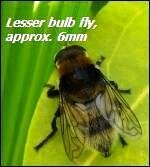
Lesser bulb fly: These prefer narcissus bulbs but occasionally can be an onion pest.
They have a similar lifestyle pattern as the onion fly, but are slightly smaller at about 5mm.
With onion fly and lesser bulb fly, say goodbye to infected onions, but future plants can be protected a couple of ways:
1. Pull up and destroy all plants infected with these onion pests at the time you know they are in the bulbs and before they have burrowed back into the soil. The fact that these onion pests work in patches or bulb by bulb down a row, makes it easier to spot plants in trouble and get them out.
Scattering onion planting throughout the garden helps, and removing the soil is also a good idea.
2. Press down the soil around seedlings well, cover with paper, cloth or other insect-proof material to stop the onion fly from laying its eggs into the soil.
3. Spreading a fine layer of sand or wood ash around the onion plants is also a good deterrent to adult onion flies from laying their eggs at the base of the plants.
 Thrips: These onion pests can wreak havoc in onion cultivation. They cut the epidermis of leaves or stems and suck the plant sap. This results in white silvery blotches on deformed leaves.
Thrips: These onion pests can wreak havoc in onion cultivation. They cut the epidermis of leaves or stems and suck the plant sap. This results in white silvery blotches on deformed leaves.
Thrips insects are female and can reproduce without a male. They thrust the eggs into leaves that hatch in five to ten days. To stop these out of control onion pests, see solutions at Organic garden pest control
Onion diseases
Damp and often warm conditions can cause a few types of onion leaf and bulb rot and infection. These onion diseases can occur during cultivation or storage. Here's a list of the most common onion diseases:Botrytis: There are three botrytis fungus species that affect onions:
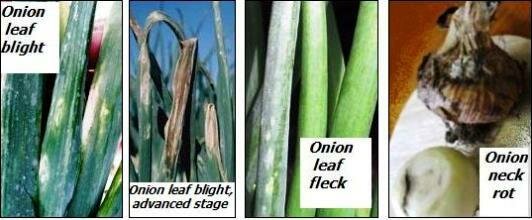
Leaf blight (Botrytis squamosa): This is popularly known as blast because it spreads so rapidly particularly in prolonged wet conditions. It causes lesions on the onion leaves which penetrate right through to the inside of the leaves.
Leaf blight looks like white or pale gold specks and eventually it kills the leaves which in turn damages the whole plant, causing it to rot and die.
Onions are most vulnerable to leaf blight when in full leaf growth and as the bulbs are forming. Dig up infected plants and burn, bury deeply away from garden, or seal in bags and remove.
Once leaf blight has a strong hold, it is hard to kill all the spores, but if you suspect infection, spray with an organic fungicide. Also, make sure you buy fresh seed for the next season.
Leaf fleck: (Botrytis cinerea) is a mild fungus and only causes surface pale green to white flecks on onion leaves. It does not damage the plants and is slow to spread.
Neck rot: (Botrytis allii) This affects stored onions, although it originates from the soil where the onions grew. The neck of the onion first goes watery, then brown, and then hardens to wizened papery leaves. Often with high humidity there is a grey mould growing between the onion layers.
Onion neck rot only attacks stored onions with tops that have taken too long to dry or have not dried sufficiently before being stored.
Avoiding thick necks on onions is important, so don't encourage growth by fertilising and irrigating late in the season when the bulbs should be maturing and tops drying.
Quickly destroy any stored onions you find with signs of neck rot and always inspect your stored produce regularly.

Downy mildew: This onion disease is fungal, and the young plants get infected in cool and damp conditions.
A white mold appears and spreads down the entire sheath, eventually causing the plant to fall over.
This can be controlled by treating young plants with an organic fungicide in weekly intervals till bulbing develops.
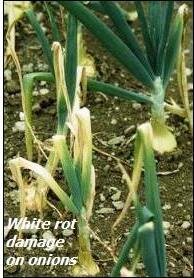
Onion White Rot: Of all the onion pests and diseases, onion white rot really will make growers "mad-dog mean", as Clint Eastwood would say.
So far impossible to eradicate, this disease is caused by the fungus Sclerotium cepivorum, which produces sclerotia — tiny dot sized black fungal bodies that can infect all members of the Allium or Onion family.
Sclerotia can hang around, seemingly dormant, in soil for up to 15 years, so it's important to take serious steps, such as:
• If possible check your source if you are planting onion sets or seedlings, and if you are in any doubt, grow onions from seeds only.
• If you've identified onion white rot, remove the infected plants and burn or seal tightly and dispose of — certainly don't compost.
• Keep any future onions a safe distance, at least 5m (16ft) away from any previous infected spots.
• Watch your shoes — don't walk on previously affected areas and then onto fresh soil because it's easy to transfer the dormant sclerotia.
The first symptoms of onion white rot are the green foliage turning yellow then dying. When the plant is pulled out there are no roots, they have been destroyed and there is nasty white mould in their place. Within that mould lurk the sclerotia.
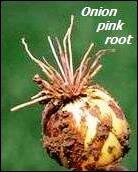
Pink root: The symptoms of this fungus really are pink roots. Only the roots and sometimes the outer layers of the bulbs get infected. They show up as pale pink first, darkening to deep reddy purple.
Pink root will actually kill the roots, because they shrivel up and go black and die off. This will stunt the hapless onions, but not necessarily kill them totally.
Crop rotation is the best defence against onion pink root. 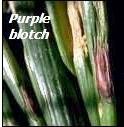
Purple blotch: In case of Purple Blotch, purple spots develop on the leaves under moist conditions, and in hot (21 to 30 degree Celsius) and humid climates.
This disease is very widespread and can be controlled by lowering planting density, good drainage and routine (weekly) spray of organic fungicides if necessary.
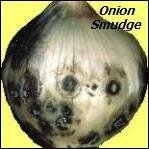
Smudge or Anthracnose: Hot and humid conditions cause the fungus anthracnose, which mostly affects mature and stored onion bulbs. The lower part of the leaves develop sunken pale patches then turn greyish and darker. The leaves become twisted due to this infection.
It is important to have healthy growing conditions using compost and good drainage. Destroy any infected plants and rotate area with other resistant crops for at least 2 years.
If caught early try an organic fungicide such as baking soda, and see fungal solutions at Organic garden pest control

Smut: This fungus can attack seedlings just as they germinate, but it doesn't always kill them. Onions that survive are not so healthy and often succumb to some other disease later even when harvested and stored.
Onion smut starts with dark lesions on the leaves of young seedlings — healthy older plants are not affected by smut spores.
The smut affected seedlings grow on to produce onions with thickened, blistered plant walls. The onions are stunted and bulbs are misshapened sometimes with quite dark blister patches. Follow the advice for smudge/anthracnose above for controlling onion smut.
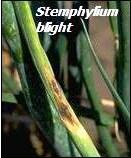
Stemphylium blight: In Stemphylium leaf blight, the symptoms, causes and remedy are similar to Purple Blotch with the difference that the blight lesions are light yellow to brown.
Remember, it's important for onion pests and diseases, and in particular harmful pathogens in the soil such as onion white rot and pink root, to rotate crops.
It might not be possible to completely rid the soil of some diseases, but they will not build up to dangerous levels if you constantly grow your onions in the same area year after year.
For all the onion pests and diseases above, hop on over to Organic garden pest control to find some handy natural solutions you can use.
Growing Onions — This is the main information page all about growing onions.
Extra Handy Tips on How to Grow Onions Get the edge for super successful onion growing.
List of Vegetables — Now you are an expert on growing onions, check out more vegetables to grow.
Back to HOME page: No Dig Vegetable Garden




